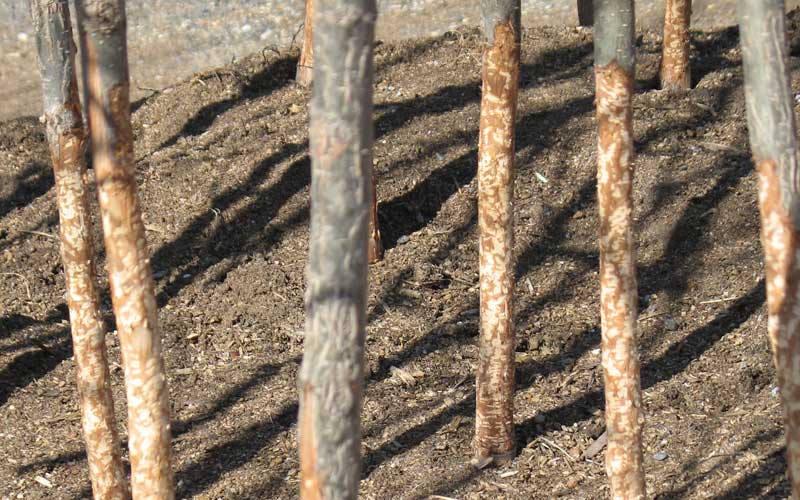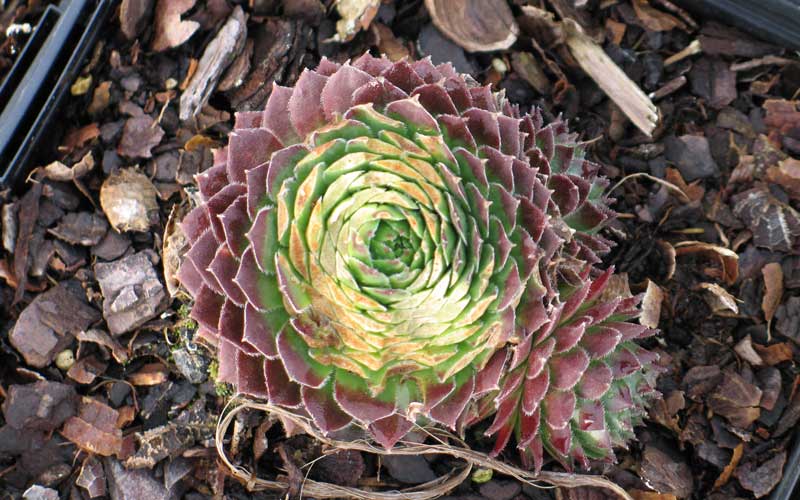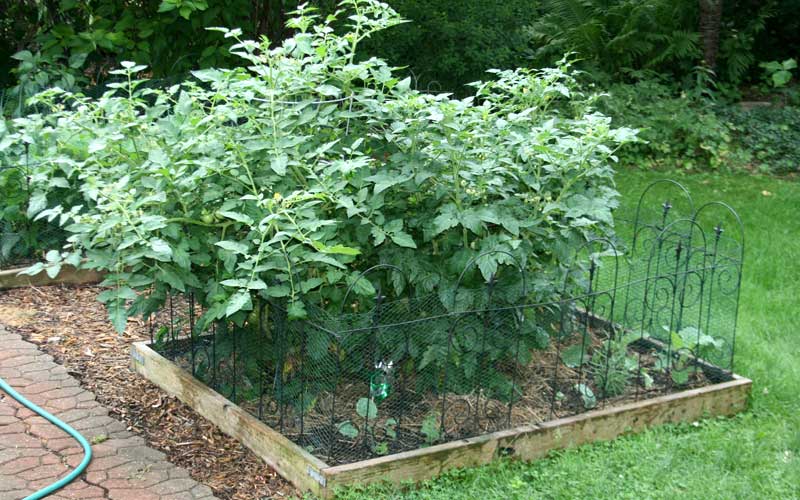How to Prevent Rabbit Damage in the Garden

I’ve lived in the same home since 1984, just outside the Beltway. So I think about seven years ago, I first became aware of rabbits in the neighborhood, and now they are pretty common. Adrian Higgins, Garden Editor of the Washington Post, commented in an article from August 2013 that gardeners had recently noticed a burgeoning rabbit population. I guess it’s not just at my place.
Since I’ve got a long-standing issue with deer using my ornamental plants for culinary purposes (paying absolutely no attention to the labels), I’ve gone with the thought that most of my yard damage is from the deer. But I know the rabbits have boldly gone into the backyard (where no deer has gone before) and eaten various perennials and bulbs. Including toad lilies (Tricyrtis), liriope, Japanese painted fern, and crocus. So I thought I should learn more about them and pass the information along.
Our rabbits are the native Eastern Cottontail. Like deer, they do well in open areas with adjacent brushy cover, typical of the suburbs. They breed like rabbits, and populations can grow quickly. (Rabbit courtship is called “cavorting.”) They feed primarily just before and after dawn and again at dusk, a pattern called “crepuscular,” which is another cool word. During the day, they mostly shelter. They don’t dig extensive warrens like the rabbits in England (as described in my favorite book about rabbits, Watership Down). Instead hide in wood or leaf piles, tall grass, or in the brush. They do dig a small hole prior to birthing in which to raise their young (which are on their own in as little as two weeks). They are active all winter.
They feed on a wide range of plants, in spring and summer preferring soft, succulent growth. This includs lawn grass and, of course, most of your vegetable garden. They feed on branches, buds, and the bark of younger shrubs and smooth-barked trees in winter and can girdle and kill young trees. (Voles, which look like mice with short tails, will also feed on bark but stay near or below the soil line. Rabbits walk on snow so that they may damage the trunks higher up.)
You can tell the difference between deer and rabbit feeding damage by looking at the ruins of your garden. Adult deer don’t have upper front teeth (which is why they can’t whistle). When they bite, they leave a ragged tear and may even pull the plant out of the ground. Rabbits make a clean cut, which photos show is at a 45-degree angle and is likened to a cut from a pruning shear.
What to do? There are rabbit repellents, which we carry at Behnke’s, similar to deer repellents. (*UPDATE as we have closed please check other local independent garden centers) I have no experience with them. I’m sure they help if you can stand the smell and apply according to label instructions regularly. If they catch them, dogs and cats kill rabbits, as do owls, hawks, and other predators.
There is also the “Rabbit Resistant Plant option.” The Missouri Botanical Garden (MOBOT) has a good article on rabbits, including a list of plants that rabbits “seldom damage” and plants that rabbits “heavily or moderately damage.” As a large and diverse botanical garden that deals with rabbits daily, these lists should be pretty good.
Some people live-trap and release rabbits elsewhere. I’ve always suspected that this is how they got going in my neighborhood. Perhaps a teacher let them go at the nearby school. Besides the ethical issue of dropping your problem on someone else who doesn’t want your rabbits any more than you do, apparently, rabbits are very territorial. The MOBOT article states: “…removing them to a location which forces them to compete for resources with other animals is likely to result in the death of one inhabitant or the other.”
As with deer, the best solution is fencing the rabbits out, either out of the yard or out of part of the yard. Unfortunately, instructions for building a free-standing fence are way outside my comfort zone, so you will have to hit YouTube or get a book.
The key to remember is that the fencing material should be metal and a tight weave, like chicken wire, so they can’t chew through it or squeeze through it. Part two of the article by Adrian Higgins referenced above (Entitled Rabbit Remedies: has three excellent illustrations regarding fencing,
I hope you can access the articles; I still get the print edition of the Washington Post, which also gives me unlimited access to the online edition.
A great suggestion from Mr. Higgins’ article was: if you have an existing fence around your yard, you can attach the chicken wire to the inside of the fence. It should be two feet or higher, reach the ground, and beheld tight to the ground with landscape staples. I think even I could do that. If fencing the entire yard is out of the question, you can build a free-standing fence around a vegetable or other garden or protect individual tree trunks with a wire cylinder around the trunk.
by Larry Hurley, Behnke horticulturist




URGENT NEED HELP ! How to get rid of ground hogs in D C
I have never had to deal with groundhogs so I don’t have much advice to offer. If I had them in my yard, I would contact an animal control company. I am including a link to an article from the University of Maryland Home and Garden Information Center (HGIC) about ground hogs.
https://extension.umd.edu/hgic/topics/groundhogs
One of our Behnke staff, Christopher Lewis, recently gave a talk here on garden pests, including groundhogs. I’ll copy him on this to see of he has any other references/comments for you.
Larry Hurley
Thank you for the informative and amusing article. Fortunately we have clover in the lawn (I encourage it’s growth) which the rabbit seems to like the best in our garden. Though he also seems to have a taste for the occasional crocus or wild geranium. I try to grow enough for me and for the rabbit.
Good for you! I imagine clover is a nutritious crop for grazers like rabbits, and the flowers are popular with bees. Plus, it fixes nitrogen in the soil (that is, can use nitrogen from the air instead of absorbing all of its needs from the soil.) Seems like you have things worked out for your garden.
Larry Hurley
Hi Larry – I’d wondered why deer don’t whistle, and now I know! Thanks 🙂
We have a few feral cats in our neighborhood and I do see hawks – maybe that’s why I’m not seeing rabbit damage. Or maybe I just hadn’t looked. I’ll check once things get a little greener.
As to Nelson with his groundhog problem – we do get an occasional one in our yard. Lots in our neighborhood are almost an acre (about 0.8-0.9 acres each) and many have wild trees, bamboo (arg!), vines, shrubs and weeds along the back of the lot (we seldom see the neighbors behind us in the summer). Groundhogs like that cover, as well as my next door neighbor’s old back yard sheds. My understanding is that other than when raising pups, groundhogs are mostly solitary, so the good news is that there’s usually only one to get rid of. Unlike moles, which eat grubs, these guys like grasses, vegetables, and fruit. Keeping the area mowed helps, but what my friends and I have found works the best is to pour stinky used cat litter down the hole! They move out in a week or two (just keep pouring the litter in). My dad grew up on a Michigan farm (he’d be 92 now) and was an organic gardener way before it was fashionable – he planted castor beans along our garden edges to keep groundhogs away. Castor bushes are quite pretty but poisonous to everyone (humans, cats, dogs) so may not be ideal for an urban setting. There are several articles online about using “Castor Oil” dilutions to spray ornamental plants or pour down the holes too. Hope this helps!
Thanks for your advice. It’s always great to hear from folks with personal experience.
On the cautious side of things…
On the kitty litter, I would always keep fresh (non-composted) manure away from vegetable gardens to reduce the risk of spreading diseases like salmonella. On making your own pesticides in general, I go with packaged pesticides (if one is necessary) and “always follow the label.”
There is a tendency for people to equate “organic or natural” with safe, but ultimately you are brewing up a poison of variable strength without the benefit of a Safety Data Sheet or a label with user safety instructions/personal safety equipment recommendations. So with castor bean, which is the source of ricin, I would want to be very careful.
Larry Hurley
I have a lot of hostas, some in ground and pots. Last year hostas in pots surrounding a gazing ball did not return. I hope you or someone else who sees this e-mail can tell me why they did not return
Higgins WAPO has not responded to my query.
Thank you.
Edna E Poe
Greenbelt MD.